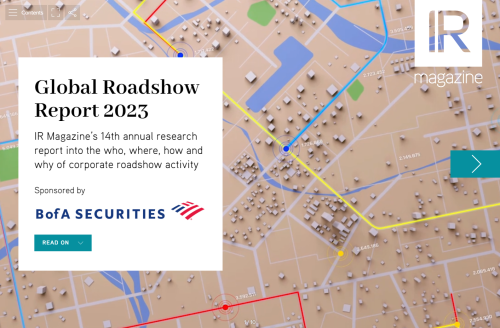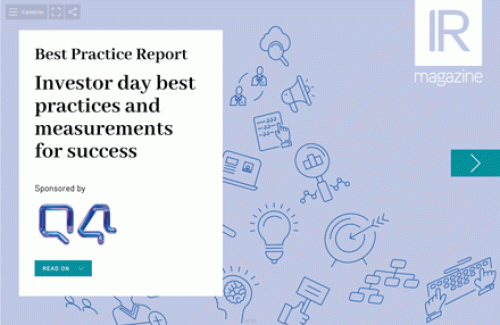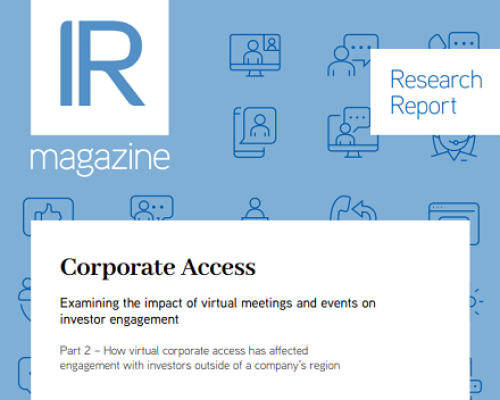Attract the SRI crowd with tips to help you cherry-pick investors
Investors can be notoriously picky, and none more so than SRI investors, who follow an investment strategy targeting financial success and social benefits through firms that promote ecological, humanitarian and even consumer-protecting ideals.
But this isn’t an area that can be ignored: in the past two years, SRI in the US has grown by more than 22 percent and, with more than $3.7 tn in total managed assets, it’s estimated that $1 in every $9 under management in the US is part of an SRI venture.
SRI investors need to be presented with a rewritten investment story, with a heightened emphasis on transparency and clear reporting in particular. Meeting with them is not easy as they often have set portfolios from which they rarely stray – so a targeted SRI-focused event may hold the key.
Centralized meeting ‘platforms’ can provide the perfect opportunity to exhibit to a large number of potential investors alongside several other firms. One such platform, Responsible Investment Corporate Access (RICA), was established through a joint venture between Belgium-based Tradinfo and Netherlands-based governance specialists Fair Impact. RICA now hosts roadshows and conferences throughout Europe, including recent ventures in Zurich and Amsterdam. Marcel Schulze, Tradinfo’s managing director, and Robert Klijn, an ESG specialist at Fair Impact, have been instrumental in its success.
For IR teams that want to organize their own events, there’s often the opportunity to present a more focused message. Frank Böhme, investor relations manager for sustainability at chemicals giant BASF, is responsible for meeting SRI investors worldwide and takes a highly transparent approach, overseen by head of IR Magdalena Moll.
Two Canadian firms – Suncor and Cenovus – are both innovative energy companies that benefit from technologies such as oil sands and wind power, and house IR teams with a definite SRI slant. Suncor’s Kelli Stevens has attended several SRI meetings and events, while Craig Stenhouse heads up Cenovus’ corporate responsibility team and meets with investors on a quarterly basis to bring across his firm’s socially conscious message. With so many different approaches, what should the novice SRI roadshow organizer focus on?
The broker connection
Brokers are often vital to beginning to put on an SRI event. In particular, where an IR team does not have a dedicated corporate responsibility professional, brokers will have the specialized contacts to make any meetings worthwhile.
‘We don’t yet see many investor relations departments hosting their own event, maybe because SRI is often the responsibility of a CSR manager who has a broader focus,’ explains Klijn.
He adds, though, that companies may be maintaining fewer broker links as that becomes less financially viable. ‘Therefore, many broker events on SRI for companies have been downsized or even stopped,’ adds Schulze. ‘We also see brokers partnering their activities, such as with our multi-broker conferences.’ At these events, brokers from different countries jointly host a series of one-on-one meetings, so costs are shared and brokers can profit from a pooled base of clients.
For most asset managers or institutional investors, the importance of the broker connection is vital. The strength of such relationships can come down to who actually does a company’s business, with investors unlikely to want to meet with firms whose brokers they do not deal with regularly.
But one investor says brokers should expect to send out some feelers on behalf of their closest IR teams to ask whether potential backers would like to hear more about their SRI offering. ‘Often, there are several firms we know we don’t want to see,’ he adds.
Though online meetings are becoming commonplace – they save on time and money and are more environmentally friendly – there’s no replacing the face-to-face effect, says Klijn. ‘People have a basic need to look each other in the eye and be able to use their senses,’ he explains. ‘This is especially true when important decisions need to be made – often with other people’s money.’
Roadshows and events also offer an opportunity to have a peek at what your SRI competitors might be doing. ‘Many brokers and companies most likely look at their competitors and peers in terms of what they offer to their investors, and nobody wants to lag behind,’ Klijn adds.
Moll agrees. ‘It is certainly easier to [communicate] messages in face-to-face meetings,’ she says. ‘We can engage directly through a conversation and get a real impression of the topics investors are eager to learn more about, what key issues they are focusing on and how they view coming trends.’
BASF bolsters its offline content with a plethora of online studies, reports and presentations, which detail performance, future objectives and sustainable product examples. ‘Most investors tend to use [these tools] as a basis for further discussion, either face to face or on the phone with the team,’ adds Böhme.
Location matters
SRI tends to be most prevalent in Europe, where the majority of portfolios follow a thematic trend rather than being exclusionary. ‘You’re far more likely to find a fund encompassing responsible fossil energy firms [in Europe] than elsewhere,’ says Böhme. ‘BASF has focused more attention in recent years on different money centers – such as London, Edinburgh, Paris and Frankfurt, to name a few – but might extend its roadshows to North America and Asia in the future.’
Schulze notes, meanwhile, that ‘the focus on SRI has not developed at the same pace around the world. In Europe the most important SRI roadshow cities are London, Paris, Zurich and Geneva and, to a lesser extent, Amsterdam, Frankfurt and Stockholm, which is basically comparable with the presence of mainstream investors.’ He adds that though investors in southern Europe are less focused on SRI, many of the companies based there are still considered ‘very progressive’.
Worldwide financial centers are a good bet, however, if you’re trying to identify new territories for SRI investors. ‘In a Canadian context, this means my meetings are usually held in Toronto or Vancouver, unless we are able to meet at our Calgary corporate office,’ explains Stenhouse. ‘Having said that, many of my meetings are arranged at networking events held across North America, in the form of either roundtable discussions or investor-related conferences.’
Stevens adds that ‘cities like Vancouver, Boston, New York and San Francisco tend to come up regularly’, because they offer an opportunity to meet up with clusters of SRI investors.
Who to see
‘We expect to see SRI analysts and investors who have a greater information demand on sustainability issues than mainstream investors or financial analysts, and thus prefer SRI roadshows with a targeted presentation,’ says Moll. ‘These meetings are about fulfilling investors’ specific information needs while also demonstrating that sustainability is imbedded in everything BASF does.’
According to Stenhouse, there are a few critical players worth prioritizing. ‘In my experience, there are a limited number of key SRI investors with the ability to affect investor sentiment and even public opinion,’ he explains. ‘Wherever possible, I try to align my own business travel with events attended by these investors so that I can continue to advance our relationship as well as inform them personally where Cenovus stands on the key issues they are interested in.’
Another possible route is to attend pertinent meetings or conferences that might be related to your firm’s responsible agenda. ‘We attend relevant conferences,’ says Stevens. ‘For example, a Suncor representative spoke at the Canadian Responsible Investment Conference held this past June in Vancouver. And our vice president of investor relations will be presenting at the SRI Conference on Sustainable Responsible Impact Investing in Colorado in October.’
What to say
In essence, the perceived wisdom is to treat an SRI roadshow like any other meeting with a large number of buy-side analysts and investors. Priorities should center on understanding funds’ investment profiles and whether your firm fits them.
‘When we are able to meet in person, we typically structure the meeting by initially providing a short overview of Suncor and sustainability,’ says Stevens. ‘We then move into a discussion, as we prefer the conversation to be open and two-way, rather than simply have us trying to relay a broadcast.’
Similar to CSR and ESG, at its most simple, SRI values three key areas: sustainability, social responsibility and corporate governance. ‘Not every investor is oriented on all these themes,’ says Klijn. ‘But you also see integrated or advanced approaches, such as responsible or impact investing, whereby SRI has become a much more integral way of running a firm.’
What should you say, then? ‘Focus your equity story on certain aspects of your business that are in the interest sphere of the SRI-oriented fund manager,’ offers Schulze. ‘We have heard of a CSR manager and an IR professional both attending one-on-ones with CSR-oriented investors, but that doesn’t necessarily happen often.’
Stenhouse says there are four main areas about which Cenovus receives information requests:
- The development of publicly stated targets with timelines, particularly centered on safety performance, greenhouse gas emissions and water use
- How his firm encourages suppliers to live up to the company’s required standards of corporate responsibility
- What types of technological improvements and innovations Cenovus is developing
- The quality of the company’s community and aboriginal relationships.
‘There is clear and substantial evidence of a positive link between a company’s ability to manage ESG issues and its ability to increase shareholder return,’ Stenhouse notes. ‘In my experience, most SRI organizations we engage with approach us from a risk-management perspective. They are looking to ensure we are managing these issues because they see them as liabilities that can affect our bottom line and – ultimately – our share price, if we are not.’
For Böhme, the structure of a presentation should depend on who you’re meeting with. For new investors, the IR team will introduce its offering with a 30 to 35-minute presentation before a short Q&A. For those familiar with the firm, the floor is opened to questions from the beginning.
‘In general, we are very flexible about how we structure the meeting and always put our focus on investors’ information demands and priorities,’ Böhme says.
| Tricks of the trade Efficient and comprehensive reporting seems central to many companies’ SRI approach. ‘Outside of face-to-face meetings, our annual corporate responsibility (CR) report is an essential tool for Cenovus to communicate with the SRI community,’ says Craig Stenhouse, head of the CR team at Cenovus. ‘In fact, most of my new relationships began with reference to our CR report. We have certainly advanced our external corporate communications and social media presence. It’s amazing how many people you can reach in such a short period of time on a number of different topics online.’ Other online features include tools like blogs, which can keep investors abreast of the latest developments within your company and any external happenings that might affect your investment story. ‘We continue to tell our story via our oil sands question-and-response blog, which focuses heavily on the sustainability side of what Suncor does,’ explains Kelli Stevens, spokesperson for Suncor. In 2006 BASF created a position specifically focused on the SRI market to serve as a direct contact for investors, so content could be tailored for purpose, especially through a specialized presentation. ‘It gives an overview of what sustainable development means to BASF, how it is anchored in our group’s strategy and how it’s put into practice,’ says Magdalena Moll, the firm’s head of IR. ‘Our sustainability targets are included, and the presentation is regularly updated to allow investors to track performance over time.’ The Sustainable Stock Exchanges Initiative, a joint venture between three UN organizations, might be a useful resource, too, says Marcel Schulze, managing director of Tradinfo. ‘The initiative wants to line up stock exchanges around the world in order to stimulate national dialogues on SRI, with the objective of breaking down any barriers that exist for the financial community [when it comes to] responsible investing.’ The Responsible Investment Corporate Access platform recently welcomed Anthony Miller, CSR focal point at the United Nations Conference on Trade and Development, to its conferences to engage with capital market authorities, stock exchange bosses and government funds. According to the buy side, there are a few practical issues that can make a world of difference. ‘The size of a room can be really important; we’ve been in situations when an event is held in a venue that’s just too small,’ explains one fund manager. ‘There’s no chance for one-on-one discussion and it can get really cramped and complicated really quickly. The ideal is to have a location with lots of different rooms with different tables – affording us the ability to actually talk with each other!’ |










